Speaker: Dr. Samuel Ng
Dr. Samuel Ng presented his current research related to the Malaysian tin-bearing granite. The seminar was very well-received.
Downloads
Flyer
Presentation (PDF)
Technical Visit to Needle Hill Tungsten Mine
Date: 2 April 2016
Speaker: Ms. Trudy Kwong
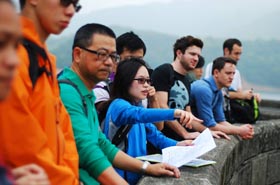 The Wolframite deposit at Needle Hill was one of the biggest tungsten mines in Hong Kong during the 1950s. Trudy, a mineral geologist, led our fellows to the Needle Hill historical mine site and showed several key places around the hill.
The Wolframite deposit at Needle Hill was one of the biggest tungsten mines in Hong Kong during the 1950s. Trudy, a mineral geologist, led our fellows to the Needle Hill historical mine site and showed several key places around the hill.
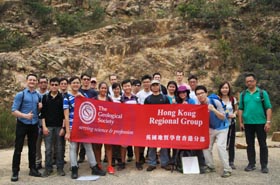
These included a disused mining office, two dump sites and several abandoned underground adits, of which one of the adits is still easily accessible. Wolframite and Molybdenite on granitic rock fragments were ubiquitous at the dump sites.
City to Desert: Mapping and Exploration in Australia
Date: 10 March 2016
Speaker: Dr. Richard Langford
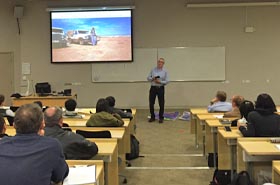 Dr. Langford illustrated a chronology of his experience in the last 20 years after leaving the Hong Kong Geological Survey in 1994. The presentation, with lots of pictures of the mapping and exploration environments he encountered, has be interwoven with a wide range of geological experiences. He showed how technological changes have been adopted over two decades, including GPS, digital mapping, hand-held XRF and remote sensing interpretation.
Dr. Langford illustrated a chronology of his experience in the last 20 years after leaving the Hong Kong Geological Survey in 1994. The presentation, with lots of pictures of the mapping and exploration environments he encountered, has be interwoven with a wide range of geological experiences. He showed how technological changes have been adopted over two decades, including GPS, digital mapping, hand-held XRF and remote sensing interpretation.
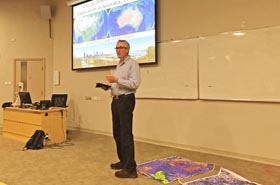
Richard also highlighted his recently published paper on Landsat imagery, and two other projects; structural controls in the Hamersley Range iron province and Ti-V stratigraphy of an Archean layered intrusion.
Downloads
Presentation (PDF)
A re-examination of joint roughness coefficient (JRC)
Date: 23 February 2016
Speaker: Dr. Louis N.Y. Wong
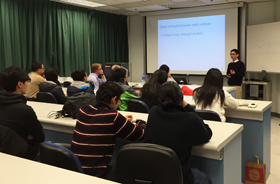 Dr. Louis N. Y. Wong was invited back to deliver a presentation to our Fellows at the University of Hong Kong. Details of his first lecture in 2015 are available further down.
Dr. Louis N. Y. Wong was invited back to deliver a presentation to our Fellows at the University of Hong Kong. Details of his first lecture in 2015 are available further down.
In an attempt to analyze the shear strength of rock joint surfaces, Dr. Wong focused on the JRC-JCS model (Barton criterion). He explained the traditional approaches used by scholars to estimate JRC and noted shortcomings to these methods.
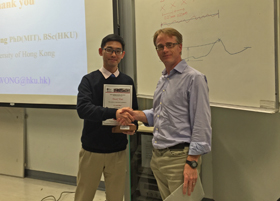
To get a more representative correlation, he revisited the correlation between JRC and roughness parameters Z2. In the new approach, a correlation which takes into consideration both slope-based and amplitude-based parameters is proposed. The methodology, possible errors in past studies and recommendations were also discussed.
Downloads
Presentation (PDF)
Technical Visit to Ma On Shan Iron Mine
Date: 4 July 2015
Speakers: Ms. Trudy Kwong & Mr. Jackie Chu
This field trip focused on the magnetite deposit in the Ma On Shan Iron Mine. The deposit is a contact metasomatic replacement skarn developed between granite and calcareous sedimentary rocks, including dolomitic limestone, within a sequence of sandstone siltstone and felsic volcanic rocks.
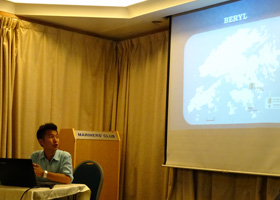
Overview of Hong Kong's Mining History
Date: 23 April 2015
Speaker: Jackie Chu
Jackie presented an overview of Hong Kong Mining History in his talk, which included details of the key minerals previous extracted in the territory (e.g. Galena, Wolframite, Magnetite, Beryl, Graphite, Quartz, Feldspar and Kaolin) as well as the locations of the main mine sites at which these were worked.
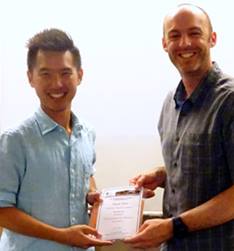
His presentation included numerous impressive graphics and photographs of the mine sites both during their working lifetime as well as their current abandoned condition. This included the historical evidence, such as old maps and local village names, which first gave him an indication of the historical mining activities in these areas.
Downloads
Presentation
Event Flyer
Infrared Spectroscopy in Engineering Geology
Date: 31 March 2015
Speaker: Nick Koor
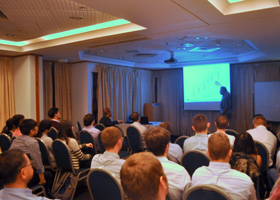 Nick presented the findings from recent work being undertaken at the University of Portsmouth on the use of visible/near-infrared (VIS/NIR) spectroscopy for geological applications such as mineral identification and logging, particle size characterisation, moisture content assessment etc.
Nick presented the findings from recent work being undertaken at the University of Portsmouth on the use of visible/near-infrared (VIS/NIR) spectroscopy for geological applications such as mineral identification and logging, particle size characterisation, moisture content assessment etc.
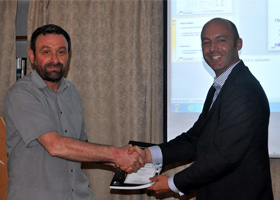
Several case studies from on-going research were presented including studies on the characterisation of landslide deposits and stratigraphic logging of the London Clay in the Isle of Wight. Nick showed how these studies were highlighting the versatility of the scanning equipment and outlined the plans for future research to further develop this emerging tool.
Downloads
Presentation
Joint Technical Seminar: Rock slope failure along non-persistent joints – insights from fracture mechanics approach.
Date: 5 March 2015
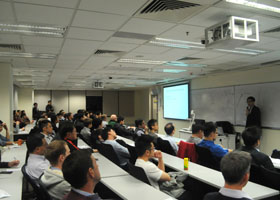 The HKRG, the Hong Kong Branch of the Institute of Materials, Minerals and Mining (IOM3) and the City University of Hong Kong jointly held an evening seminar on rock slope failure along non-persistent joints, presented by Dr. Louis N. Y. Wong of Nanyang Technological University (NTU) in Singapore.
The HKRG, the Hong Kong Branch of the Institute of Materials, Minerals and Mining (IOM3) and the City University of Hong Kong jointly held an evening seminar on rock slope failure along non-persistent joints, presented by Dr. Louis N. Y. Wong of Nanyang Technological University (NTU) in Singapore.
Rock slope failure is often associated with the sliding of a rock block along a pre-existing discontinuity, where instability is structurally controlled. However, the persistence of key discontinuity sets is typically limited. The failure of rock slopes thus requires a complex interaction (such as coalescence) between non-persistent discontinuities to form a persistent slide plane. Although the Mohr-Coulomb failure criterion with a tensile cut-off can be conveniently applied to model the failure of the intact rock bridge between non-persistent joints, the stress concentration effects around the tips of discontinuities are undesirably ignored.
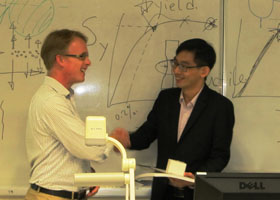 This talk presented another approach (see attached presentation material) that incorporates a fracture mechanics failure criterion to simulate the nucleation or activation of cracks within the rock matrix and their possible coalescence. The cracking and slope failure behavior of various pre-existing discontinuity configurations obtained numerically was also compared with those observed in experimental studies.
This talk presented another approach (see attached presentation material) that incorporates a fracture mechanics failure criterion to simulate the nucleation or activation of cracks within the rock matrix and their possible coalescence. The cracking and slope failure behavior of various pre-existing discontinuity configurations obtained numerically was also compared with those observed in experimental studies.
Downloads
Presentation
HKRG AGM 2015
Date: 25 February 2015
The HKRG held its Annual General Meeting on 25 February 2015 to report on activities held over the previous year and elect the committee for the coming 2015/16 Committee Session (see Chair's Report below). This was followed by an evening talk by Kevin Styles of Fugro Hong Kong Limited on “Geologists: Our worth & Are We Worthy”, a copy of which is also uploaded for reference.
By the close of the nomination period for committee membership, a total of 18 names had been put forward meaning that voting was required for the positions of Secretary, Treasurer and Ordinary Committee Membership. The AGM and Evening Talk were extremely well attended with 70 people turning up to vote on the committee members, which by the close of voting on the evening comprised:
Chair: Stuart Millis
Secretary: Fergus Cheng
Treasurer: Raymond Sung
Ordinary Committee Members: Hoi-Yan Ho, Emily Kai, Sarah Kong, Dickson Leung, Andrew Malone, Stephen Power, Iain Ross & Denise Tang
We look forward to this committee maintaining the high levels of activity achieved by the those representing the HKRG in previous years.
Downloads
Chair's Report 2014-15
AGM Talk by Kevin Styles
Evening Seminar: The Performance of Rock Slopes during the 2010/11 Canterbury Earthquake Sequence
Date: 19 January 2015
Time: 6.30 - 7.30pm
Venue: Lecture Theatre 10 (LT-3), 4/F Academic 1, City University of Hong Kong
Speaker: Dr Chris Massey
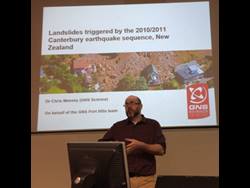
Synopsis
The Canterbury earthquake sequence triggered thousands of rockfalls in the Port Hills of Christchurch, New Zealand, with over 6,000 falling on 22 February 2011. Several hundred families were evacuated after about 200 homes were hit. Chris is currently leading a research project to quantify the seismic response of slopes in Christchurch and Wellington, New Zealand.
Chris's talk highlighted observations, measurements and modelling results to discuss how rock slopes in the Port Hills of Christchurch, New Zealand, performed during the 2010/11 Canterbury earthquake sequence, and how they might perform in the future?.
About the Speaker
Dr. Chris Massey is an Engineering Geologist with over 18 years of research and consultancy experience, primarily in the investigation and analysis of complex geological and geotechnical data for geohazard assessments, slope stability (including landslide monitoring), foundation, underground/surface rock support and groundwater assessments. He has applied these skills to hazard assessments, highway, town planning, pipeline and mining engineering projects in Malawi, Bhutan, Nepal, Ethiopia, Russia (Sakhalin Island), Tajikistan, Hong Kong, Australia, Europe, UK and New Zealand. Recently Chris has lead a project assessing the rockfall and landslide risk to residential homes in the Port Hills of Christchurch, New Zealand, following the 2010/2011 Canterbury earthquake sequence.
Downloads
Flyer